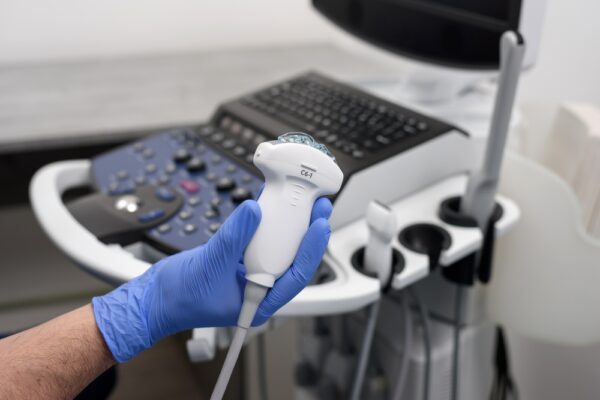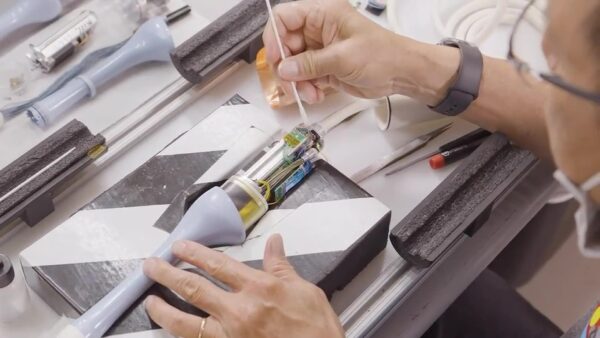The Risk of Electrical Leakage in Ultrasound
Ultrasound equipment experiences a lot of wear and tear, and it’s prone to incidental damage. All it takes is an accidental drop, and defects are likely to follow. Even out of the box, ultrasound equipment should be tested, calibrated, and validated prior to use.
 One potentially serious risk is electrical leakage in ultrasound probes, which can compromise patient safety.
One potentially serious risk is electrical leakage in ultrasound probes, which can compromise patient safety.
When aging, poorly maintained, or underserviced ultrasound probes are not consistently evaluated, the risk of electrical leakage grows. Unfortunately, not all diagnosticians are well versed in electrical leakage testing, or even the potential threats to look out for, so it is important to vet the knowledge and accreditation of your ultrasound diagnostic and service provider.
Understanding electrical leakage in ultrasound
Electrical leakage refers to the unintentional escape or loss of electrical signals within the ultrasound system, coupled with the intrusion of fluid into the probe’s interior. When electrical signals leak, it means the intended signal path is disrupted. Some of the electrical energy used to generate the ultrasound signal is lost or diverted to unintended areas.
Leakage can occur in various ultrasound components such as cables, connectors, transducers, or amplifiers. Regardless of where it occurs, leakage can negatively affect the quality and accuracy of the ultrasound images — and can potentially introduce artifacts or distortions. It leads to issues like reduced sensitivity, decreased image resolution, or increased noise levels in the ultrasound images.
 Risks associated with electrical leakage
Risks associated with electrical leakage
One of the biggest risks associated with probe damage is a drop in scan fidelity. The purpose of ultrasound is to identify and assess different pathologies — a purpose that comes under threat if equipment doesn’t function as intended.
Electrical leakage can interfere with the transmission and reception of ultrasound signals, resulting in poor image quality and compromised diagnostic accuracy. Distorted or incomplete images can lead to misinterpretation of findings and incorrect diagnoses, potentially impacting patient care and treatment decisions. Further, defective equipment creates ripple effects that can disrupt workflows, delay patient care, and necessitate costly repairs or equipment replacement.
In cases where known issues of electrical leakage impact diagnosis or treatment, healthcare providers and facilities may even face legal repercussions. Failure to adhere to regulatory standards, neglect of electrical leakage testing, or inadequate maintenance can result in lawsuits, damage to reputation, and financial liabilities.
The role of electrical leakage testing
Electrical leakage testing plays an important role in identifying the primary reason for artifacts or signal degradation as the result of an electrical issue. Proper testing serves to identify the issue, outline the proper repair method, and ensure patient safety.
As mentioned, electrical leakage can affect any major component in an ultrasound system. It’s important to perform a full diagnostic evaluation of the equipment to pinpoint exactly where leakage is occurring and whether the problem is multifaceted or limited to a single defect. Comprehensive testing also helps rule out other issues that might cause artifacts or loss of fidelity, such as delamination or crystal damage.
Fixing potential hazards
Ultrasound equipment malfunctions leading to electrical leakage could include issues with insulation, grounding, or power supply. Thankfully, modern ultrasound machines are designed with multiple safety features and safeguards to prevent serious malfunction. In testing ultrasound equipment, technicians can quickly identify where a minor malfunction has occurred and make repairs restoring the integrity of the equipment. Full system testing also paves the way to better calibration, improving the utility of the system even after repair.

Ensuring patient safety
Ultrasound systems are designed to be safe and minimize electrical risks. But if leakage occurs, it can introduce unintended electrical currents into the patient’s body. In addition, fluid intrusion into the probe can pave the way for pathogens, which put patients at risk in procedures such as transesophageal echocardiography (TEE). System shock or transfer of pathogens via fluid are both preventable issues that start with equipment maintenance.
Mitigating the risk of electrical leakage
Manufacturers design ultrasound systems with careful consideration of shielding, grounding, and insulation techniques — all to minimize the potential of electrical leakage. Through the course of normal use and incidental damage, these features become compromised, creating electrical leakage. This is why regular maintenance, inspection, and proper handling of the equipment are crucial. Ensuring ultrasound equipment works as expected and as intended leads to better clarity in diagnostic imaging — and the confidence that comes from better diagnosis and treatment.

 Risks associated with electrical leakage
Risks associated with electrical leakage